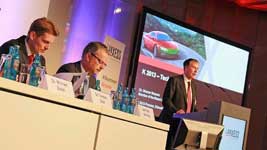
With more than 40% of its sales accounted for by the automotive sector last year, it is no surprise that German speciality chemicals firm Lanxess’s focus is on green mobility. According to Werner Breuers, member of the Lanxess Board of Management, at a preview press conference in Düsseldorf in July, “Worldwide there are more than 1 billion cars on our roads, and by 2050 this figure is expected to rise to 2.5 billion. Sustainable mobility is therefore becoming a global megatrend.”
Last year, the firm invested EUR192 million – around 2.1% of its sales – in R&D, which is 33% more than in the previous year. Plus, the firm is also focusing on the growth markets in China, India, Russia and Brazil, where it is also strengthening its presence significantly, said Breuers. In June, the firm opened a 100,000-tonne/year butyl rubber plant in Singapore to cater to the need for green tyres with low rolling resistance.
Meanwhile, the firm’s High Performance Materials (HPM) business unit’s focus is on lightweight automotive construction based on Durethan and Pocan polyamides and polyesters. This was recently reinforced by the acquisition of Bond-Laminates, a manufacturer and supplier of continuous fibre-reinforced thermoplastic performance composites marketed under the Tepex brand. “We are now one of the few thermoplastics manufacturers in the world that can supply performance composites and compounds proven in large-scale production, complete with the associated applications know-how for the volume production of lightweight components,” said Michael Zobel, head of HPM. Among some lightweight construction components are front end carriers consisting entirely of PA6 and a car brake pedal made of glass fibre-reinforced PA, suitable for large-scale series production. The firm also opened a technical centre for automotive parts testing in Hong Kong this year.
In the rubber sector, Lanxess is promoting its Keltan EPDM reinforced with the ACE technology that allows it to produce EPDM without the use of chlorine in a high-purity process and with a more tighter composition. “Seven grades in the EPDM portfolio have the ACE technology to thank for their superior performance. It is also enabling us to add new EPDM grades to our portfolio,” said Torsten Derr, head of the Keltan Elastomers business unit. Here, the company has invested in the world’s largest EPDM plant at Changzhou, China, with a capacity of up to 160,000 tonnes/year. Start of production is scheduled for 2015.
Furthermore, the High Performance Elastomers business unit is pursuing the development of nitrile-butadiene rubber (NBR) grades and new Baymod powder NBR grades, with a new compounding step in polychloroprene production to extend the range of applications for this rubber. Two new product families, Baypren HP and GF, have been innovated. Baypren HP includes products with properties that are not yet available on the market, says the firm, while the polyethylene-vinyl acetate (EVM) Levapren materials under development include a grade for impact resistance modification of PLA. The business unit has also invested in Asia, with a 30,000-tonne/year nitrile rubber plant opened in Nantong, China, in May 2012 in conjunction with a partner.
(PRA)














